New Digital Economy and the Paradox of Productivity - ఆర్బిఐ - Reserve Bank of India
New Digital Economy and the Paradox of Productivity
|
by Sadhan Kumar Chattopadhyay, Sreerupa Sengupta and Shruti Joshi^ This article estimates the contribution of digitalisation to productivity growth and examines the Solow Productivity paradox for India. The analysis indicates that the contribution of Information and Communication Technology (ICT) to output growth increased from 5.0 per cent in 1981-1990 to 13.2 per cent during 1992-2023. On average, the ICT sector’s productivity fared better than the non-ICT sector for the whole sample period. Introduction Digitalisation, a form of innovation, is expected to improve productivity in the long run (Solow, 1987). First, digital technologies let businesses innovate by streamlining operations and lowering expenses associated with communications with clients and suppliers (Akerman et al., 2013). Second, information and communication technology (ICT), when used as an input in the production process, also improves productivity via deepening. Third, companies can reduce their ICT expenditures and associated costs like energy, labour and maintenance by switching from owning ICT assets to acquiring ICT services. The economy’s overall productivity performance may eventually benefit from these savings as they improve resource allocation and increase efficiency (van Ark, 2020). Some studies have contended that the rise of the new digital economy has not been accompanied by a subsequent rise in productivity (van Ark, 2016). Moreover, the recent work of Acemoglu et al. (2014), Brynjolfsson and McAfee (2014) and Bartelsman et al. (2017) do not find any significant impact of digitalisation on productivity. These studies have reignited discussions over Robert Solow’s 1987 “productivity paradox” resurgence in the light of sluggish global productivity growth. Following the global trend, India is also experiencing rapid digitalisation, and the impact of digital goods and services on India’s economic growth has become more pronounced, especially after the COVID-19 pandemic (Gajbhiye et al., 2022). While a host of studies examine the existence of a productivity paradox in advanced economies, especially OECD countries, there are limited studies that enrich understanding of the existence of a productivity paradox in emerging market economies like India. In this light, this article examines the existence of a productivity paradox in India. Following Das and Erumban (2016), the effect of digitalisation1 on productivity is assessed through two separate channels - (i) the contribution of ICT as an input in driving output and labour productivity growth and (ii) estimating the productivity potentials by examining the differential between ICT sector and non-ICT sector. The remaining sections of the article are arranged as follows. Section II deals with the literature survey on digitalisation and the productivity paradox. Section III describes the data and methodology used in this paper. Section IV presents the results of the empirical analysis for digitalisation and the productivity paradox for India. Finally, the last section concludes the study. The weak association between ICT and productivity was described as “computer is everywhere except in productivity statistics” –known as the “Solow Paradox” in literature. Early studies on ICT and productivity found evidence of the Solow paradox and found an insignificant relationship exists between ICT and productivity (Berndt and Morrison, 1995; Brynjolfsson and Yang, 1996; Franke, 1987). Schreyer (2001) argued that when ICT was at its infant stage, its share in the total economy was too low, and hence, it was not reflected in productivity. Further, using ICT in a wide range of activities and internalising its full benefits take a long time (Basu and Fernald, 2007). Brynjolfsson (1996) found that labour and capital in the Information Technology (IT) industry have a substantial relationship with output and that the marginal products of IT industries are larger than those of non-IT industries. According to Brynjolfsson and Hitt (2000), IT capital increased output growth and productivity in the short term (with a one-year lag), but the impact was five times larger in the long term (with a five to seven-year lag). Siegel and Griliches (1992) found a significant positive relationship between computer investment and productivity growth in developed economies. van Ark and Inklaar (2006) found that the association between the use of ICT and productivity was U-shaped, which suggests that returns of ICT investment are initially followed by a period of experimentation, during which it shows a negative relation with TFP growth. In the later phase, productivity gains are realised in line with the marginal cost of ICT. In a related study, van Ark (2008) found that the slower development of the knowledge economy in Europe relative to the US was the cause of the decline in productivity in that continent. According to these findings, higher IT investment is linked to higher productivity growth rates. The productivity paradox seems to have surfaced again. The recent trends in global productivity indicate that despite the increasing adoption of digital technology, particularly in the form of cloud computing, i-cloud, big data, and robotics across the globe, there has been a fall in productivity growth in both advanced economies as well as emerging economies (Conference Board total economy database). Gopane (2020) confirmed the emergence of a new productivity paradox with accelerated digitalisation in the production process that is not manifested in productivity growth statistics. All these studies have reinvigorated discussions on Solow’s 1987 productivity paradox. Some authors point out that digital technologies have had only a transitory impact on productivity and will not fundamentally alter long-term living standards (Gordon, 2012). Others argue that firms are in the learning phase, and there is a time lag between digital technology adoption and the effect to be reflected in TFP numbers (van Ark, 2016). Moreover, even with new empirical research, there are limited studies that deepen the understanding of the productivity paradox in emerging market economies. For India, Jorgenson and Vu (2005), using ICT spending data from the World Information Technology and Services Alliance (WITSA), estimate the total investment in ICT in the economy. Erumban and Das (2016) found an increased contribution from ICT investment to India’s overall economic growth, mostly focused on the service sector. This article builds on Erumban and Das (2016) in two ways - first, it directly examines the productivity paradox for India using regression techniques and analyses the productivity difference between the ICT and non-ICT sectors. Erumban and Das (2016) have used shift share and Domar aggregation2 analysis to identify the contribution of ICT and non-ICT sectors to aggregate TFP growth in India. Secondly, the present study covers a larger period from 1980 to 2019 and uses Conference Board and India KLEMS datasets. The literature has segmented the digital economy into ICT-producing and ICT-using sectors (Mesenbourg, 2011) - the former produces ICT infrastructure while the latter uses ICT for another economic process. van Ark (2003) has also provided a classification of industries based on ICT usage. Based on van Ark (2003), 27 KLEMS industries are classified into ICT-using, ICT-producing and non-ICT industries. In addition to van Ark, Erumban and Das (2016) have also classified KLEMS industries in a similar way. Based on van Ark (2003), the contribution of ICT and non-ICT to labour productivity and TFP growth is examined. Lastly, it also tests whether there is any significant difference in the productivity of ICT and non-ICT industries. The study uses the growth accounting approach suggested by Jorgenson et al. (2007), which is as follows: 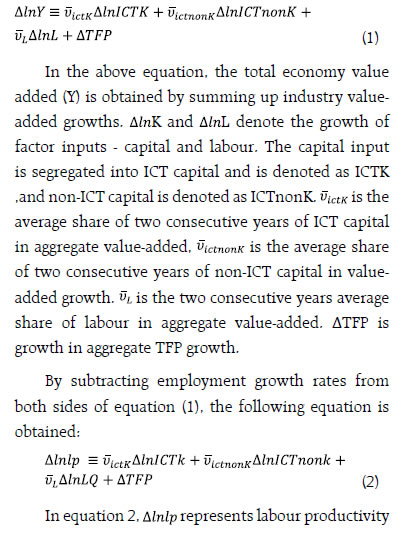  To estimate the above equation, the study utilises the KLEMS-India dataset published by the RBI. The KLEMS framework measures factor inputs within the production function approach, while incorporating a quality index in input measurement. For instance, labour input categorises educational attainment to address productivity variations between low and high-skilled labour services. Similarly, the measurement of capital stock accounts for asset heterogeneity. The gross value added (GVA) data in KLEMS are derived from India’s National Accounts Statistics (NAS). Labour data are based on quinquennial Employment Unemployment Survey (EUS) rounds for 1991-2016 and Periodic Labor Force Survey (PLFS) data for 2017 onwards. Employment and wage data are categorised based on the skill level of workers defined by education categories. Wage rates for self-employed workers are estimated using the Mincer equation (KLEMS Manual, 2023). Capital input data in the KLEMS framework is estimated from NAS data by obtaining investment data categorised by asset type. The capital stock is estimated using the perpetual inventory method, assuming an 8.0 per cent depreciation rate for machinery, 2.5 per cent for construction, and 10.0 per cent for transport equipment, respectively (KLEMS Manual, 2023). The rental price of capital represents the external rate of return. Capital input at the total economy level is segregated into ICT and non-ICT capital using data from the Total Economy database (2023), Conference Board, published by Groningen University, Netherlands. IV. Effect of ICT on GVA and Productivity Growth As seen from Chart 1a, the share of the ICT sector in the total economy GVA increased over time. In particular, this is true for ICT-using services, whereas the share of non-ICT service sectors and non-ICT other sectors (agriculture, mining, construction, electricity) has declined. The share of ICT-producing/ using manufacturing sectors, on the other hand, has remained constant over time (Chart 1a and 1b). The contribution of ICT capital as an input to GVA and labour productivity growth is further analysed by estimating Equations 1 and 2 described above. The decomposition results show that ICT capital services, on average, contributed 5.0 per cent to output growth during 1981-91 and this contribution increased to about 16.0 per cent during 1992-2000 and 14.3 per cent during 2001-2010. Subsequently, it moderated to 10.3 per cent during 2011-2023 (Chart 2a). The share of ICT capital deepening to labour productivity growth rose from 8.4 per cent in 1981-90 to 20.8 per cent during 1992-2000 and 17.4 per cent during 2001-2010, suggesting an improvement in the role of ICT capital investment in catalysing output and productivity growth during the 1990s and 2000s. The share of ICT capital deepening to labour productivity growth fell to 11.3 per cent during 2011-23 (Chart 2b). These results indicate that during 1980s to 2000s, the contribution of ICT to productivity was high, refuting the productivity paradox but the paradox appears to have emerged in the; post-2010s period consistent with the global trends (Sayeh, Dabla-Norris and Kinda, 2023). Is the Difference in Productivity Statistically Significant? It is observed that, on average, the performance of the ICT sector is better than that of non-ICT in terms of partial and aggregate productivity. Next, in order to examine if the productivity difference between ICT and non-ICT sectors is statistically significant, the following regression equations are estimated. 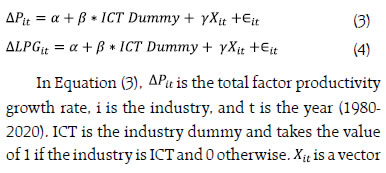 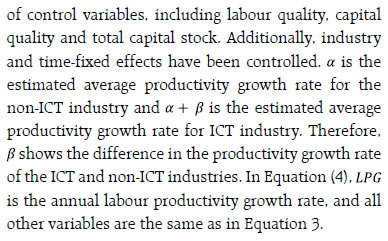 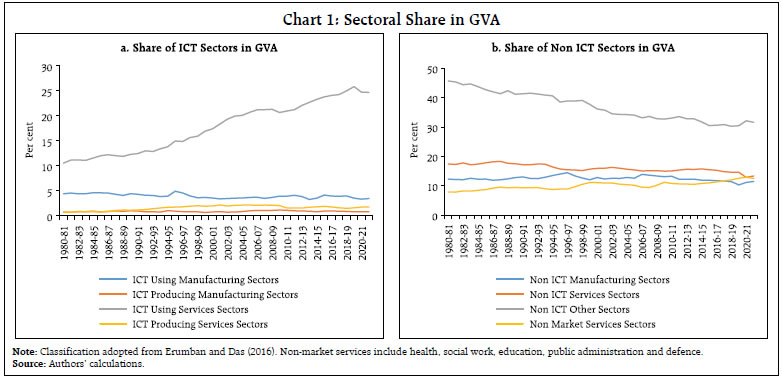 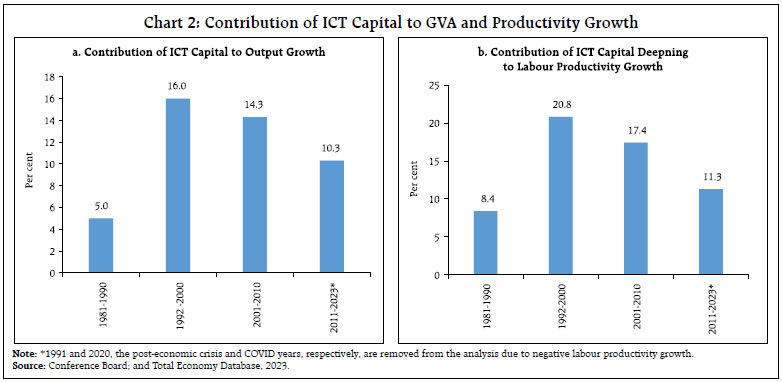 The results from Table 1 show that, on average, the ICT sector’s productivity performance, which includes both ICT-producing and ICT-using sectors, is higher than the non-ICT for the entire period 1980-2020. Next, the model was run for different sub-periods. It is found that the productivity impact of ICT was the highest from 1980 to 2010. However, during the period from 2010 to 2020, the productivity differential between the ICT sector and the non-ICT sector was insignificant, consistent with the post-GFC productivity slowdown observed in many parts of the world. These results are corroborated in Table 2. In terms of labour productivity growth, the ICT sector performs better than the non-ICT sector for the full period and subsequent sub-periods. Although a slight moderation in labour productivity growth is observed in the last decade, overall, the ICT sector’s productivity performance was better than that of the non-ICT sectors. ICT-using vs ICT-producing industries To identify the productivity differences between ICT producing and ICT using sectors, the following regressions are run for the disaggregated ICT sectors:  A dummy for ICT-using and producing industries is introduced in equations (5) and (6). The dummy takes a value of 1 if the industry is ICT-using and 0 if it is ICT-producing. From Table 3, it is found that, on average, the productivity performance of ICT-producing industries was better than that of ICT-using industries. Further, from Table 4, in terms of labour productivity, the ICT-producing sector also outperforms the ICT–using sector. The moderation in the labour productivity growth of the ICT sector in 2000-2020 is attributable to the moderation in the labour productivity growth rate of ICT–using industries. Hence, industries that produce ICT goods and services or use ICT in the provision of goods and services have higher productivity than those that are less intensive users of ICT, with the gap between the productivity of ICT and non-ICT increasing over time. VI. Conclusion This article aims to analyse the role of ICT in driving productivity growth in India using two approaches. In the first approach, the role of ICT capital as an input in driving output growth and productivity is examined. The second approach studies the productivity differentials between ICT and non-ICT sectors using regression models. The stylised facts indicate that the contribution of ICT capital to output and labour productivity growth increased in the post-liberalisation period, during 1980s-2000s, with some moderation subsequently. These inferences are supported by regression results. Hence, ICT contributed to productivity growth during this period, thereby refuting Solow’s productivity paradox for India. However, in the latter half of the 2010s, marked by the beginning of new digital technologies, the productivity differential between the ICT sector and the non-ICT sector has been insignificant, consistent with the post-GFC productivity slowdown observed in many parts of the world. References Acemoglu, D., Gallego, F. A., and Robinson, J. A. (2014). Institutions, human capital, and development. Annu. Rev. Econ., 6(1), 875-912. Akerman, A., Gaarder, I., and Mogstad, M. (2013). The skill complementarity of broadband internet. IZA Discussion Papers 7762. Institute for the Study of Labor (IZA). URL http://ideas.repec.org/p/iza/izadps/dp7762.html. Bartelsman, E. J., and Wolf, Z. (2017). Measuring productivity dispersion. Basu, S., and Fernald, J. (2007). Information and communications technology as a general-purpose technology: Evidence from US industry data. German Economic Review, 8(2), 146-173. Berndt, E. R., and Morrison, C. J. (1995). Hightech capital formation and economic performance in US manufacturing industries: An exploratory analysis. Journal of Econometrics, 65(1), 9-43. Brynjolfsson, E., and Hitt, L. (1996). Paradox lost? Firm-level evidence on the returns to information systems spending. Management Science, 42(4), 541-558. Brynjolfsson, E., and Hitt, L. M. (2000). Beyond computation: Information technology, organizational transformation and business performance. Journal of Economic Perspectives, 14(4), 23-48. Brynjolfsson, E., and Hitt, L. M. (2003). Computing productivity: Firm-level evidence. Review of Economics and Statistics, 85(4), 793-808. Brynjolfsson, E., and McAfee, A. (2011). Race against the machine: How the digital revolution is accelerating innovation, driving productivity, and irreversibly transforming employment and the economy. Brynjolfsson, E., and McAfee, A. (2014). The second machine age: Work, progress, and prosperity in a time of brilliant technologies. WW Norton and Company. Brynjolfsson, E., and Yang, S. (1996). Information technology and productivity: A review of the literature. Advances in computers, 43, 179-214. Erumban, A. A., and Das, D. K. (2016). Information and communication technology and economic growth in India. Telecommunications Policy, 40(5), 412-431. Franke, R. H. (1987). Technological revolution and productivity decline: Computer introduction in the financial industry. Technological Forecasting and Social Change, 31(2), 143-154. Gajbhiye, D., Arora, R., Arham,N., Rigzen,Y., and Ishu,T. (2022). Measuring India’s digital economy. RBI Bulletin. Gopane, T. J. (2020). Digitalisation, productivity, and measurability of digital economy: evidence from BRICS. In Digital Economy. Emerging Technologies and Business Innovation: 5th International Conference on Digital Economy, ICDEc 2020, Bucharest, Romania, June 11–13, 2020, Proceedings 5 (pp. 27-37). Springer International Publishing. Gordon, R. J. (2012). Is US economic growth over? Faltering innovation confronts the six headwinds. National Bureau of Economic Research (No. w18315). Inklaar, R., Jäger, K., O’Mahony, M., and van Ark, B. (2020). European productivity in the digital age: evidence from EU KLEMS. Measuring economic growth and productivity (pp. 75-94). Academic Press. Jorgenson, D. W., and Vu, K. (2005). Information technology and the world economy. The Scandinavian Journal of Economics, 107(4), 631-650. Jorgenson, D. W., Ho, M. S., and Stiroh, K. J. (2008). A retrospective look at the US productivity growth resurgence. Journal of Economic Perspectives, 22(1), 3-24. McAfee, A., and Brynjolfsson, E. (2008). Investing in the IT that makes a competitive difference. Harvard Business Review, 86(7/8), 98. Mesenbourg Jr, T. (2011). The role of the commodity flow survey in understanding the US economy. Transportation Research Circular, (E-C158). Santini, T., and Araujo, R.A. (2021). Productivity growth and sectoral interactions under Domar aggregation: A study for the Brazilian economy from 2000 to 2014. Economic Structures 10, 14. Schreyer, P., and Pilat, D. (2001). Measuring productivity. OECD Economic studies, 33(2), 127-170. Siegel, D. S., and Griliches, Z. (1991). Purchased services, outsourcing, computers, and productivity in manufacturing. van Ark, B. (2016). The productivity paradox of the new digital economy. International Productivity Monitor, 31, 3-18. van Ark, B., and Inklaar, R. (2006). Catching up or getting stuck? Europe’s troubles to exploit ICT’s productivity potential. van Ark, B., Inklaar, R., and McGuckin, R. H. (2003). ICT and Productivity in Europe and the United States Where do the differences come from? Cesifo Economic Studies, 49(3), 295-318. van Ark, B., O’Mahony, M., and Timmer, M. P. (2008). The productivity gap between Europe and the United States: Trends and causes. Journal of Economic Perspectives, 22(1), 25-44.
^ The authors are from the Department of Economic and Policy Research, Reserve Bank of India, Mumbai. The views expressed in this article are those of the authors and do not represent the views of the Reserve Bank of India. 1 As per OECD (2020) the extent of digitalisation can be measured by estimating the contribution of the ICT sector to economic growth. 2 Domar aggregation is a weighted sum of industrial productivity growth, with the sum of its weights higher than unity in input-output economies (Santini and Araujo, 2021). 3 The contribution of labour is split into the contribution of pure employment quantity and labour quality. |
||||||||||||||||||||||||||||||||||||||||||||||||||||||||||






















